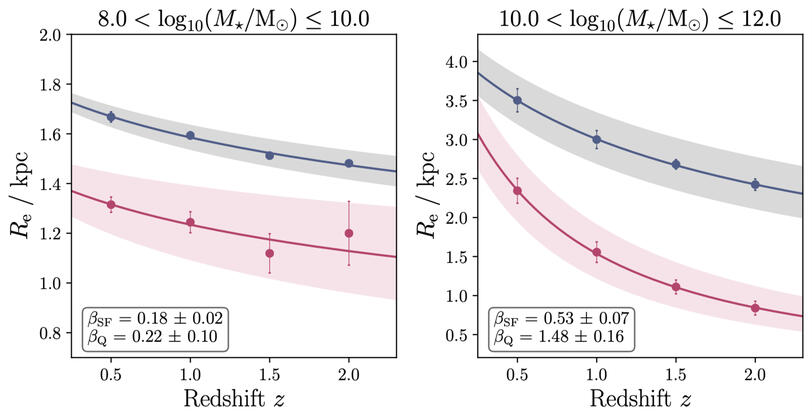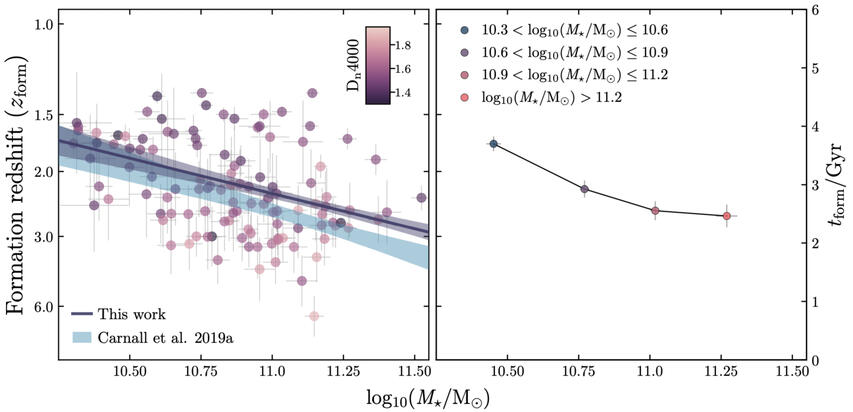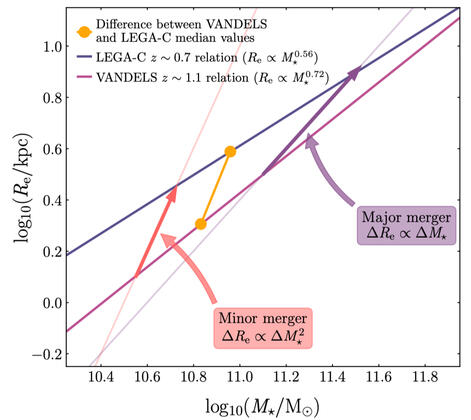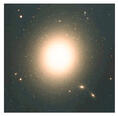About
I recently started a postdoc at the University of Massachusetts Amherst, working with Kate Whitaker & Francesco Valentino (at DAWN, Copenhagen) on the star-formation histories of massive quiescent galaxies at cosmic noon. Prior to this position, I completed a PhD at the Institute for Astronomy, University of Edinburgh, under the supervision of Ross McLure. I studied size-mass relations, star-formation histories and quenching mechanisms of quiescent galaxies at z ~ 1 using a range of data from the ESO Public Spectroscopic Survey VANDELS, and the JWST PRIMER program.
research
DeepDive: SFHs of massive quiescent galaxies at z > 3
At UMass, I am leading the DeepDive science project on star-formation histories. I am investigating the formation and quenching timescales of massive quiescent galaxies at Cosmic Noon to try and understand their properties from spectrophotometric fitting. Stay tuned for some exciting research!
JWST PRIMER: strong evidence for environmental quenching of low-mass galaxies out to z ≃ 2
Using high-quality imaging and photometry from the JWST PRIMER Survey (PI: Dunlop), I selected large samples of quiescent galaxies over a wide stellar mass and redshift range to investigate whether or not low-mass quiescent galaxies are morphologically different to their higher mass counterparts. In this paper, I find that at all redshifts, low-mass quiescent galaxies are more disk-like than high-mass quiescent galaxies, and possess a shallower size-mass relation, more consistent with the star-forming relation over the same stellar-mass range.
the connection between stellar mass, age and quenching timescale in massive quiescent galaxies at z ≃ 1
Using a spectroscopic sample of 114 quiescent galaxies in the VANDELS survey at 1.0 < z < 1.3, we study the relationship between age, stellar mass and quenching timescale. When combined with recent literature results, we find evidence that the slope of this relation remains consistent over the redshift interval 0 < z < 4. The galaxies within the VANDELS quiescent display a wide range of star-formation histories, with a mean star-formation timescale of 1.5 ± 0.1 Gyr and a mean quenching timescale of 1.4 ± 0.1 Gyr. We also find a large scatter in the quenching timescales of the VANDELS quiescent galaxies, in agreement with previous evidence that galaxies at z ∼ 1 cease star formation via multiple mechanisms. We then focus on the oldest galaxies in our sample, finding that the number density of galaxies that quenched before z = 3 with stellar masses log (M /M ) ≥ 10.6 is ~1.12 x 10−5 Mpc−3. Although uncertain, this estimate is in good agreement with the latest observational results at 3 < z < 4, tentatively suggesting that neither rejuvenation nor merger events play a major role in the evolution of the oldest massive quiescent galaxies within the redshift interval 1 < z < 3.
a VANDELS & LEGA-C study: the evolution of quiescent galaxy size, stellar mass and age from z = 0.6 to z = 1.3
We study the relationships between stellar mass, size and age within the quiescent population, using two mass-complete spectroscopic samples with log (𝑀★/M⊙) > 10.3, taken from VANDELS at 1.0 < 𝑧 < 1.3, and LEGA-C at 0.6 < 𝑧 < 0.8. Using robust Dn4000 values, we demonstrate that the well-known ‘downsizing’ signature is already in place by 𝑧 ≃ 1.1, with Dn4000 increasing by ≃ 0.1 across a 1 dex mass interval for both VANDELS and LEGA-C. We then proceed to investigate the evolution of the quiescent galaxy stellar mass-size relation from z ≃ 1.1 to z ≃ 0.7. We finally split our sample into galaxies above and below our fitted mass-size relations, to investigate how size and Dn4000 correlate. For LEGA-C, we see a clear difference; larger galaxies have smaller Dn4000 at fixed stellar mass. Due to the faintness and smaller numbers of the VANDELS sample, we cannot confirm whether a similar relation exists at z ≃ 1.1. We find the observed evolution in size, mass and Dn4000 across the ≃ 2 Gyr from z ~1.1 to z ~ 0.7 can be explained by a simple toy model in which VANDELS galaxies evolve passively, whilst experiencing a series of minor mergers.
Surveys
Curriculum Vitae
Click here for my full CV.
Academic Positions
University of Massachusetts Amherst 2024 - present
Postdoctoral Research Associate
Institute for Astronomy, University of Edinburgh 2023 - 2024
Postdoctoral Research Associate
Education
Institute for Astronomy, University of Edinburgh
PhD Astronomy: 2019 ‐ 2023
Thesis title: Constraining quenching mechanisms at high redshift: the sizes, masses & SFHs of massive galaxies
Advisors: Prof. Ross McLure, Dr. Adam Carnall, Prof. James Dunlop
Imperial College London
MSc Physics: 2018 - 2019
Advisor: Prof. Stephen Warren
Queen Mary University of London
BSc Astrophysics: 2014 - 2018
Advisor: Prof. Richard Nelson
Publications (first author)
M. L. Hamadouche, R. J. McLure, A. Carnall, K. Whitaker. et al. 2025. JWST PRIMER: strong evidence for the environmental quenching of low‐mass galaxies out to z ≃2.
MNRAS, 541, 463-475, doi: 10.1093/mnras/staf971
M. L. Hamadouche, A. C. Carnall, R. J. McLure, J. Dunlop et al. 2023. The connection between stellar mass, age and quenching timescale in massive quiescent galaxies at z ≃ 1.
MNRAS, Mar. 2023, doi: 10.1093/mnras/stad773
M. L. Hamadouche, A. C. Carnall, R. J. McLure, J. Dunlop et al. 2022. A combined VANDELS and LEGA‐C study: the evolution of quiescent galaxy size, stellar mass and age from z = 0.6 to z = 1.3.
MNRAS, 512, 1262‐1274; doi: 10.1093/mnras/stac535
Contact
[email protected]Dr. Massissilia Hamadouche
Office: LGRT-517O
Department of Astronomy,
University of Massachusetts Amherst
Amherst, MA, 01003






